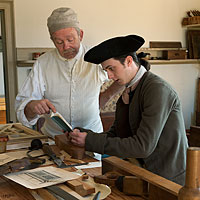« Back to main article “Every Man Able to Read”

David Salisbury as a master teaching his apprentice, Levi Walker, to read, as apprenticeship contracts required.
Sidebar:
Literacy in Virginia
by Harold B. GillIt is hard to say how many people in the mid-eighteenth-century Williamsburg area were literate. Unlike writing, reading leaves no direct trace, so we are left with few sources to measure the ability to read and write—the definition of literacy. At that, none of the sources gives an accurate picture.
It has been argued that if a person could sign his name, he was to a degree literate, and there is evidence some people could read but not write. Some saw no need of it. Isaac Watts, the prolific writer of hymns, thought that rural children should be taught to read, but there was no need for them to be able to write.
Scholars Kenneth Lockridge and Lawrence Cremin attempted to determine literacy by studying signatures on wills and other legal documents and found that literacy was higher in New England than in the South. Robert and Katherine Brown analyzed post-Revolutionary petitions and found that most white Virginians were literate. It should be noticed that Virginia law required that:
If any Parents, by their own idle or dissolute Lives, or by neglecting to educate their Children, or to instruct them in Christian Principles, are judged by the County Court to be incapable of supporting and bringing up their Children, upon Certificate thereof, granted by the Court, the Churchwardens of that Parish wherein the Children live, may bind them out to Service, or Apprentices, as if they were poor Orphans.
The masters of all apprentices, orphans or not, were required to teach, or cause to be taught, the apprentice to read and write. Some apprentice indentures required the apprentice to be given a year’s schooling.
Then I set out to arrive at some idea of the rate of literacy in the middle eighteenth-century Williamsburg area, I decided to examine only witnesses to legal documents. My thought was that then, as now, whoever was present acted as witnesses. I did not count testators or deed grantors because those people may have been better off than the average.
Many wills were written near the time of death of the testator, who may have been unable to sign because of feebleness or some other reason. Whoever was present witnessed the signature. The witnesses give a better cross-section of the population than witnesses on deeds because deeds were often written in an office.
To estimate the degree of literacy among the white population in the Williamsburg area, I examined witnesses to documents in two York County Court record books, Deed Book 5, 1741–54, and Wills and Inventories 20, 1745–59. Williamsburg was partly in York County during the eighteenth century.
In these volumes, 439 individuals signed documents as witnesses. Forty-seven, or 10.7 percent, signed with marks—suggesting a literacy rate of 89.3 percent. Of the 439 witnesses, 387 were men. Of them, 6.2 percent signed with marks, indicating a literacy rate among white men of 93.8 percent. Of the 52 female witnesses, 53.85 percent signed their names.
Darrett and Anita Rutman in their intensive study of Middlesex County, Virginia, found that between 1700 and 1750 58.8 percent of white men were literate and 100 percent among the middle and upper classes from 1720 to 1744. My findings in York County are probably fair estimates.
Historian Harold Gill the journal’s consulting editor, contributed to the holiday 2007 issue “The Curious Doctrine of Benefit of Clergy.”
